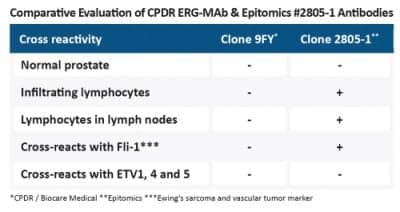Adeza Biomedical, Sunnyvale, Calif, founded 20 years ago to focus on women’s reproductive health care, is behind a test and testing unit for women at risk of preterm birth. The company was recently acquired by Cytyc Corp, which is well aligned with Adeza’s area of expertise as a provider of surgical and diagnostic products targeting women’s health. CLP spoke with Dean Koch, vice president of marketing, about the science behind the company’s products, its presence in the lab, and what the company will be doing in the coming years. www.adeza.com
Q: What is Adeza’s flagship product?
A: Our flagship product is FullTerm, the Fetal Fibronectin Test. In 1999, we introduced a rapid instrument called the TLi IQ. That’s when fetal fibronectin really exploded onto the scene, because the physicians were looking for a rapid turnaround test for likelihood of preterm birth. In a woman with signs and symptoms of preterm labor, a negative (normal) FullTerm result rules out delivery for the next 14 days with 99.2% accuracy. This has resulted in a huge shift in how triage for preterm labor is managed. The women with a positive test result have about a 17% risk of delivery in the next 14 days, and about 50% risk for preterm delivery (less than 37 weeks). These are the women who will benefit from the limited interventions available for preterm labor.
Q: What is your newest or most cutting-edge product?
A: FullTerm is definitely cutting edge, with tremendous research in preterm delivery, induction of labor, and other pregnancy applications ongoing. We also have a new drug application for a drug that we’re calling Gestiva—the substance is called 17—Hydroxyprogesterone Caproate. It’s a therapeutic candidate for the prevention of preterm birth in women with a history of preterm delivery.
Q: Is the FullTerm test being administered as a part of routine checkups for pregnant women?
A: The way I would characterize it is in a triage setting, when someone has symptoms of preterm labor, fetal fibronectin is considered standard-of-care for assessing the risk of preterm birth. We have over 1,600 hospital customers, really all the major obstetric centers—80% of teaching hospitals—and the American College of OBGYN has a practice bulletin covering that use and endorsing its use as evidence-based. Where we’ve been spending more time in the last couple of years is in the more routine management of women with elevated risk of preterm birth because of their current pregnancy or their clinical history. When you have a high-risk population, and some of the risk factors physicians would be really concerned about—history of preterm birth, multiple gestations, or some sort of cervical issue—fetal fibronectin is being adopted at a pretty quick rate to help make decisions about their management.
Q: What is the turnaround time on the TLiIQ? Is it considered a point-of-care test?
A: It’s a very simple instrument to operate, though it’s typically not at the point of care. Of our 1,600 hospital customers, I would guess that [fewer] than 50 are in a point-of-care-type setting. When the specimen is collected, it’s placed in a tube that we provide with a buffer solution. It’s stable for 8 hours at room temperature, so it doesn’t need to be in any special storage. Once the laboratory gets it, they pipette 200 µL onto a rapid-reaction cassette that is then placed in the instrument. It incubates for about 20 minutes, allowing for color development, and then the instrument takes about 2 and a half minutes to read the results. It’s got on-board quality control, and it’s looking for color development, which it matches to a stored lot-number-specific calibrator to produce either a positive or negative result. Once it hits the lab, it takes about 23 minutes to run a test. Most of our hospital customers are turning results back to the floor in about an hour, or certainly less than two hours.
Where OBs run into trouble is if a hospital doesn’t have a TLi IQ, and they have to send it across town to another hospital, and you’re getting into 6- or 8-hour turnover time. What happens without fetal fibronectin is the vast majority of those women will end up getting treated and admitted, and the drugs that they’re using have a lot of side effects. It’s very costly for the hospital, for insurance companies, and, of course, for the women themselves. Just as important are the women who may have their symptoms subside, but would have proven positive for the presence of fetal fibronectin. This is the single best predictor of preterm delivery risk. That’s why we have such wide adoption of the technology.
Q: What is on the horizon for Adeza?
A: Adeza is focused on women’s reproductive health care. The things we are most excited about are continuing the development of FullTerm, and also Gestiva, our pending drug application with the FDA. To be able to have the only diagnostic test for predicting the risk of preterm birth, and then also to bring to market a drug that may reduce the risk of preterm birth in select populations—it’s a very powerful combination. We’re very excited about that. A lot of people don’t know that fetal fibronectin was originally called oncofetal fibronectin because it is also produced by certain cancerous tumors. We are very excited by research that has been conducted by other sites as well as our own research in the area of bladder cancer.
Zac Dillon is associate editor for CLP. For more information, contact .





